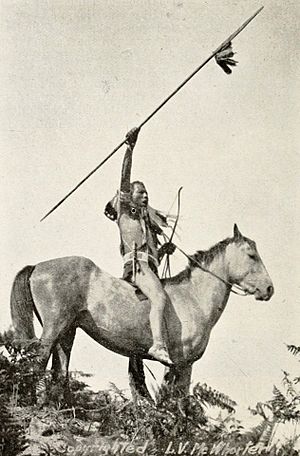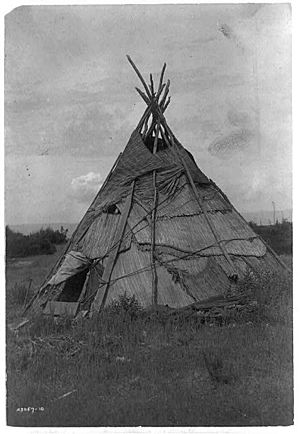Yakama facts for kids

Yakama warrior ca. 1913,
photographed by Lucullus V. McWhorter |
|
| Total population | |
|---|---|
| 10,851 (2000 Census) | |
| Regions with significant populations | |
| United States ( |
|
| Languages | |
| English, Ichishkíin Sínwit | |
| Related ethnic groups | |
| Klickitat Tribe Klickitat |
The Yakama are a Native American tribe living mainly in eastern Washington state. There are nearly 10,851 members.
Today, Yakama people are part of the federally recognized tribe called the Confederated Tribes and Bands of the Yakama Nation. Their home, the Yakama Indian Reservation, is along the Yakima River. It covers about 1.2 million acres. The Yakama Tribal Council, with members from 14 tribes, leads the nation today.
Many Yakama people fish for salmon, steelhead, and sturgeon. They fish in the Columbia River and its smaller rivers. This includes land the tribe once owned. Their right to fish in their old lands is protected by special agreements called treaties. Courts in the late 1900s, like in the Boldt Decision (1974), confirmed these rights.
Contents
What Does "Yakama" Mean?
People have different ideas about where the name Yakama comes from. Some say the Sahaptin words E-yak-ma mean "a growing family." Others say iyakima means "pregnant ones." Some scholars think yákama means "black bear," or ya-ki-ná means "runaway."
The Yakama people also had other names. They were called Waptailnsim, meaning "people of the narrow river." They were also called Pa'kiut'lĕma, meaning "people of the gap." This name describes where they lived along the Yakima River. The Yakama call themselves the Mamachatpam.
Historic Yakama Groups and Lands
The name "Yakama" was first used for five (and sometimes six) main groups. These groups spoke the same language or dialect of Sahaptin. This language is also known as Ichishkíin Sɨ́nwit, which means "this language." These groups often named themselves after a special rock, their main camps, or a good fishing spot.
Many English names for rivers in the area come from Sahaptin words. These include the Klickitat, Umatilla, Walla Walla, Palouse, Yakima, Satus, Toppenish, Tieton, and Wenatchee rivers.
- Lower Yakama (called Mámachatpam by the Yakama): These were the people of Chief Kamiakin. They lived along the Lower Yakima River, east of the Cascade Mountains. They were called "Lower Yakima" to tell them apart from the "Upper Yakama" (Kittitas) who lived further upriver. They were the largest group. Their lands stretched from Selah and Wenas (north of today's Yakima) south to Prosser. Many rivers like the Naches, Ahtanum, Toppenish, and Satus creeks flow into the Yakima River in this area.
- Pa'kiut'-ħlama (″People of the gap″): This was an important group of the Lower Yakama. Their main village was in the valley between Ahtanum Ridge and Rattlesnake Ridge.
- Thápnĭś-ħlama (also called Toppenish): This group lived along Toppenish Creek. The town of Toppenish is named after them.
- Taptat-ħlama (″People at the rapids″): They lived along the Yakima River near Prosser, which has waterfalls. This was a key fishing spot.
- Upper Yakama or Kittitas (called Pshwánwapam by the Yakama): These were the people of Chief Owhi and Chief Qualchan. Their lands were usually north of Wenas and Selah Creeks, along the Upper Yakima River. They lived in the northern Yakima River area, including the Cle Elum River, Teanaway River, and Kachess River. Their land also included three large lakes in the Cascade Mountains: Cle Elum Lake, Kachess Lake, and Keechelus Lake.
- Klikatat / Klickitat (called Xwálχwaypam by the Yakama): These were the people of Chief Slockish. Their lands were north of the Columbia River. They lived near the beginnings of rivers like the Cowlitz, Lewis, Washougal, White Salmon, and Klickitat rivers.
- Cowlitz Klickitat (called Taitnapam by the Yakama): These people were close to their Yakama relatives. They lived in the Upper Cowlitz, Cispus, Tilton, and Lewis River areas. They had strong language and family ties to the Yakama and Klickitat.
- Wanapum / Wánapam (″River People″): They lived south of the Saddle Mountains, along both sides of the Columbia River. Their most important village and fishing area was at Priest Rapids. In 1953, the building of the Priest Rapids Dam flooded their homes. Today, about 60 Wanapam still live near the dams. A famous Wanapam leader was Smohalla, who started the Washane ("Dreamer Religion").
- Mishalpam (called Mical-ɫa'ma by the Yakama): These people were later called Upper Nisqually. They were the people of Chief Leschi. Their lands were west of the Cascade Mountains. They lived along the Mashel River and the Upper Nisqually River and Puyallup River. Their lands reached up to Mount Rainier. They often married people from the Nisqually tribe. Chief Leschi was an important leader during the Puget Sound War in 1855 and 1856.
The Yakama lands were mostly east of the Cascade Range, in the area of the Yakima River. To the south, they lived along the northern rivers that flow into the Columbia River. Here, Yakama groups often lived in villages with other Sahaptin-speaking groups like the Umatilla. To the northeast, their lands reached the Wenatchee River. To the north, they lived near the lakes of Cle Elum Lake, Kachess Lake, and Keechelus Lake. To the west, across the Cascade Mountains, their lands reached the beginnings of the Cowlitz River, Lewis River, and White Salmon River.
History of the Yakama
The Yakama people were like other native groups of the Columbia Plateau. They were hunters and gatherers. They were well-known for trading salmon that they caught during the yearly salmon runs in the Columbia River. In 1805 or 1806, they met the Lewis and Clark Expedition where the Yakima River meets the Columbia River.
After the Walla Walla Council and the Yakima War of 1855, the tribe had to give up much of their land. They were forced to move to their current reservation. The Treaty of 1855 named 14 tribes and groups that joined together as the "Yakama Nation." These included the Lower Yakama, Palouse, Wenatchi, Klickitat, and others. The name of the tribe was changed from Yakima to Yakama in 1994. This change was made to match how the native people say the name.
Language
The Yakama language is a type of Sahaptin. Sahaptin is part of the Plateau Penutian language family. Since the late 1900s, some native speakers have wanted to use the traditional Yakama name for their language: Ichishkíin Sínwit. The tribe's Cultural Resources program wants to replace the word Sahaptin. This is because Sahaptin means "stranger in the land."
Notable Yakama People
 In Spanish: Yakama para niños
In Spanish: Yakama para niños



